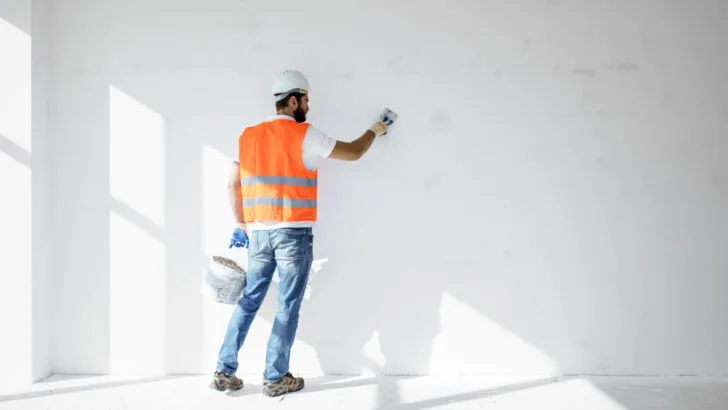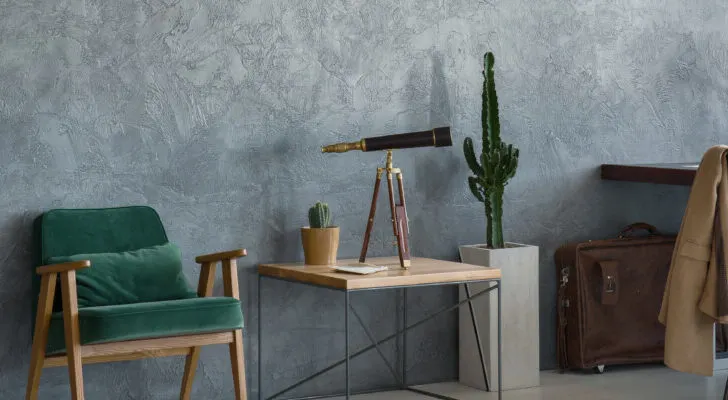Whether you’re renovating your current home or designing one from scratch, a difficult choice you’ll be faced with is deciding between smooth vs. textured walls.
In general, smooth walls are better because they are more practical, affordable, and easier to maintain. However, some people still prefer textured walls because they give homes a unique aesthetic and are more durable than smooth coats, making them better for longevity.
In this article, we’ll be taking a closer look at the characteristics, costs, and maintenance of smooth vs. textured walls to help you decide which one is better for your home.
Smooth vs. Textured Walls
Many homeowners find themselves feeling conflicted when needing to decide on the wall design for the interior of their homes. The two most common options are smooth and textured walls, both of which come with pros and cons.
In general, most homeowners find smooth walls to be more practical and affordable compared to textured walls. They are easier to apply, maintain, and often cost considerably less than textured walls.
On the other hand, textured walls are great for adding a unique aesthetic to a home and for covering up imperfections on walls. In addition, they will usually last quite a bit longer than smooth coats.
However, choosing between smooth vs. textured walls is ultimately a subjective decision. You need to evaluate the style of your home, your budget, and the aesthetic that you want to achieve, as these will be crucial factors for determining, which type is better for your household.
To help you understand this better, we need to break down the advantages and disadvantages of smooth vs textured walls in more detail.
Smooth Walls: Advantages & Disadvantages
For the last 20 years or so, smooth walls have been a crowd-favorite and go-to pick among homeowners painting their walls. Smooth-painted walls use skim coat paint to create a clean and smooth look, which is currently the most popular choice for modern households.

With that said, although smooth-painted walls are more popular, that does not necessarily make them the better choice over textured walls. There are advantages and disadvantages to smooth walls that you should consider before you commit.
Advantage: Affordable
If you want to paint your walls on a budget, the skim coat paint used for smooth walls is generally the most reliable approach.
Smooth-painted walls are easy to apply and you can finish an entire home for relatively cheap, with most homeowners paying $1.10 to $1.30 per square foot.
Advantage: Repainting
It’s recommended that you repaint your walls every 5 to 10 years. One of the best advantages to having smooth walls is that there is very little prep required when you decide to re-paint.
In most cases, you can simply paint over the existing smooth coat and add a new finish to the walls. This is very simple to do and many homeowners can repaint their walls without professional help.
Advantage: Aesthetic
If you like to have a clean and smooth aesthetic in your home, smooth walls are going to be the way to go.
With minimalism becoming a growing trend, many people prefer to have walls that look smooth to complement the design of the rest of the household.
Advantage: Smooth Texture

The texture of your walls is not only a visual aesthetic for your home but also something that you will physically touch. Many people prefer having their interior walls feel smooth and uncluttered.
Disadvantage: Extensive Preparation
A drawback to applying skim coat paint to your walls to achieve that smooth aesthetic is that you need to prepare the walls before you can begin painting.
Although you may have not noticed it, walls often have bumps, grooves, and imperfections that can sabotage the look of your skim-coat paint. All of these imperfections need to be smoothened out before you can begin painting.
Disadvantage: Noticeable Imperfections
This factor ties into extensive preparation, especially if you did not do it right! A major disadvantage to smooth coat paint is that any imperfections in your walls will become very noticeable.
If you prepped the walls perfectly, this will not be an issue. However, leaving behind any bumps, lines, or grooves in the walls before you apply the paint can result in a poor look and feel.
Disadvantage: Expensive Labor
Most homeowners are equipped with the skills necessary to paint their homes. However, if there is a lot of prep required before you can start, you may find that the bulk of the time is spent preparing, not painting.
There are a lot of mistakes that you can make when applying any kind of paint to your walls, including smooth coats. To ensure that the job is done right, many homeowners resort to hiring professional painters, which adds to the final costs.
Textured Walls: Advantages vs Disadvantages
Textured walls were very popular 40 to 50 years ago until smooth coats began to dominate the scene. However, in recent years, textured walls have been seeing a comeback, with many homeowners preferring them over smooth coats.

With that said, we need to consider that there are various types of textured wall options that you can install in your home. These are the most common types of textured walls:
- Popcorn walls
- Faux stucco
- Orange peel walls
- Textured wallpaper
- Knockdown
Each textured wall type has it’s own aesthetic and characteristics, giving homeowners plenty of options to choose something that fits their tastes. Much like smooth walls that use skim coats, textured walls come with certain advantages and disadvantages.
Advantage: Aesthetic
The biggest selling point of textured walls is their aesthetic. If you want to have a home with a unique style that stands out, utilizing textured walls in the interior is one of the best ways to do so.
Given how many different options you have to choose from when picking out a textured wall design, this opens up a lot of doors for creative interior design.
Advantage: Less Preparation
What’s great about textured walls is that there is very little prep required before you can apply them. Given that walls can often have imperfections that need to be fixed before you can paint, this demands a lot of time and effort from your end.
Advantage: Hides Imperfections
If you have walls with lots of bumps, cracks, and grooves, one of the best ways to conceal them is to simply add a textured wall material.
Textured walls are the ultimate solution for covering up imperfections in your walls. You can improve the aesthetic of your home without having to prep or deal with flaws once the project is complete.
Advantage: Durability
A key selling point for many homeowners is that textured walls are more durable. The materials used for textured walls often act as a barrier, protecting the walls from damage.
This preserves the integrity of the interior of your home, which ultimately keeps its value from diminishing. In addition, many textured wall materials will last for decades before needing to be replaced, making this a great solution for any homeowner who values longevity.
Disadvantage: Expensive
Homeowners who are renovating on a budget should approach textured walls with careful consideration.
Applying textured materials to your walls can be very expensive compared to traditional paint. This can make textured walls less appealing to people who want to improve the aesthetic of their homes without breaking the bank.
With that said, the cost of textured walls can greatly vary depending on the material that you choose. In general, homeowners pay around $1 to $3 per square foot when applying texture to their walls.
Disadvantage: Professional Installation
Installing textured walls is usually more than the average homeowner can handle on their own.
To ensure that installation was done properly, many people prefer to call in professional contractors to apply the textured material to their walls. This factor alone can add quite a lot to your final costs.
Disadvantage: Difficult to Remove
Although textured walls will last for years, you may have to remove the material at some point when the time comes to replace it.
This can prove to be quite challenging with certain textured materials. Unlike repainting, textured walls require you to strip away the previous material before a new one can be applied.
Removing the material often requires professional help, which implies that there will be more costs down the line when you want to strip away the textured material.
Key Takeaways to Smooth vs. Textured Walls
Smooth walls are often better because they are more practical, affordable, and easier to maintain.
Some people still prefer textured walls because they give homes a unique aesthetic and are more durable than smooth coats, making them better for longevity.
Ultimately, choosing between smooth vs. textured walls is subjective, and homeowners should decide between the two based on the characteristics that they value more.


